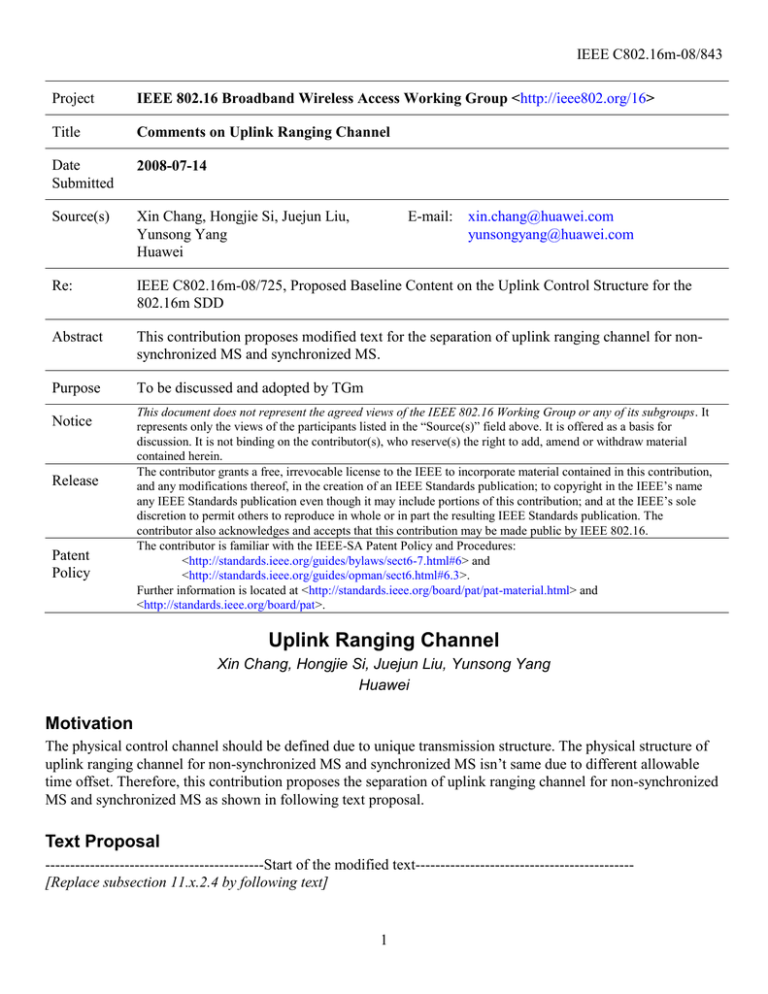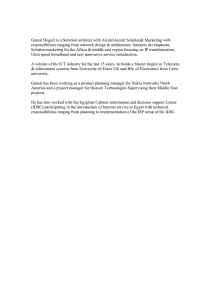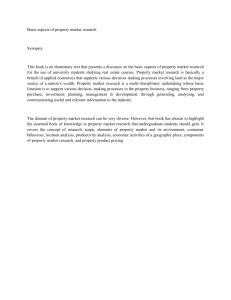IEEE C802.16m-08/843 Project Title
advertisement

IEEE C802.16m-08/843 Project IEEE 802.16 Broadband Wireless Access Working Group <http://ieee802.org/16> Title Comments on Uplink Ranging Channel Date Submitted 2008-07-14 Source(s) Xin Chang, Hongjie Si, Juejun Liu, Yunsong Yang Huawei Re: IEEE C802.16m-08/725, Proposed Baseline Content on the Uplink Control Structure for the 802.16m SDD Abstract This contribution proposes modified text for the separation of uplink ranging channel for nonsynchronized MS and synchronized MS. Purpose To be discussed and adopted by TGm Notice Release Patent Policy E-mail: xin.chang@huawei.com yunsongyang@huawei.com This document does not represent the agreed views of the IEEE 802.16 Working Group or any of its subgroups. It represents only the views of the participants listed in the “Source(s)” field above. It is offered as a basis for discussion. It is not binding on the contributor(s), who reserve(s) the right to add, amend or withdraw material contained herein. The contributor grants a free, irrevocable license to the IEEE to incorporate material contained in this contribution, and any modifications thereof, in the creation of an IEEE Standards publication; to copyright in the IEEE’s name any IEEE Standards publication even though it may include portions of this contribution; and at the IEEE’s sole discretion to permit others to reproduce in whole or in part the resulting IEEE Standards publication. The contributor also acknowledges and accepts that this contribution may be made public by IEEE 802.16. The contributor is familiar with the IEEE-SA Patent Policy and Procedures: <http://standards.ieee.org/guides/bylaws/sect6-7.html#6> and <http://standards.ieee.org/guides/opman/sect6.html#6.3>. Further information is located at <http://standards.ieee.org/board/pat/pat-material.html> and <http://standards.ieee.org/board/pat>. Uplink Ranging Channel Xin Chang, Hongjie Si, Juejun Liu, Yunsong Yang Huawei Motivation The physical control channel should be defined due to unique transmission structure. The physical structure of uplink ranging channel for non-synchronized MS and synchronized MS isn’t same due to different allowable time offset. Therefore, this contribution proposes the separation of uplink ranging channel for non-synchronized MS and synchronized MS as shown in following text proposal. Text Proposal --------------------------------------------Start of the modified text-------------------------------------------[Replace subsection 11.x.2.4 by following text] 1 IEEE C802.16m-08/843 11.x.2.4 UL Ranging Channel The UL ranging channel is used for UL synchronization. The UL ranging channel can be further classified into ranging channel for non-synchronized MS and synchronized MS. A random access procedure, which can be contention based or non-contention based is used for ranging. Contentionbased random access is used for initial ranging, periodic ranging and handover. Non-contention based random access is used for periodic ranging and handover. 11.x.2.4.1 Ranging Channel for Non-Synchronized MS The ranging channel for non-synchronized MS is used for initial access and handover. 11.x.2.4.1.1 Multiplexing with other control channels and data channels The UL ranging channel ranging channel for non-synchronized MS starts at a pre-determined location with the configuration defined in a DL broadcast control message. The UL ranging channel ranging channel for non-synchronized MS is FDM with other UL control channels and data channels. 11.x.2.4.1.2 PHY structure The ranging channel for non-synchronized MS consists of three parts: cyclic prefix (CP), preamble, and guard time. The length of the CP shall be longer than the sum of the maximum channel delay spread and round trip delay (RTD) according to the supported cell size. The length of GT shall be also longer then maximum RTD according to supportable cell size. The length of the preamble shall be equal to or longer than the CP length of the ranging channel for non-synchronized MS. The details on the length of each part and its configurations are FFS. The localized physical resource is allocated for the ranging channel for non-synchronized MS. The ranging sequence design and mapping to subcarriers are TBD. [The ranging sequence can be defined per user class, per service class and per sector. Users are classified based on operatorspecific network performance requirements and service level agreements.] 11.x.2.4.2 Ranging Channel for Synchronized MS The ranging channel for synchronized MS is used for periodic ranging. 11.x.2.4.2.1 Multiplexing with other control channels and data channels The UL ranging channel ranging channel for synchronized MS starts at a pre-determined location with the configuration defined in a DL broadcast control message. The UL ranging channel ranging channel for synchronized MS is FDM with other UL control and data channels. 11.x.2.4.2.2 PHY structure The structure of UL ranging channel resource blocks, pilots and resource mapping are TBD. The ranging sequence design and mapping to subcarriers are TBD. [The ranging sequence can be defined per user class, per service class and per sector. Users are classified based on operatorspecific network performance requirements and service level agreements.] 2 IEEE C802.16m-08/843 --------------------------------------------End of the modified text-------------------------------------------- 3



